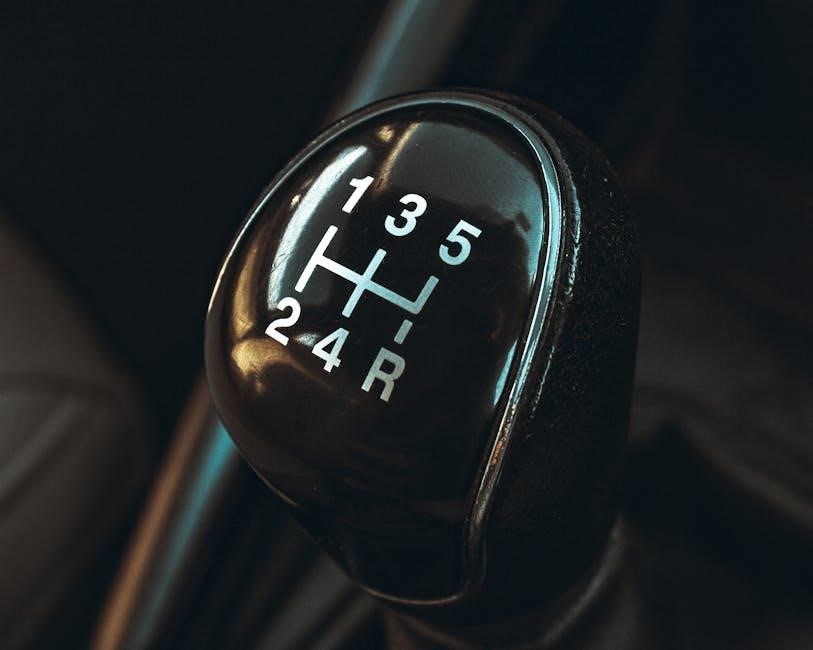The E36 manual gearbox is a popular choice among BMW enthusiasts, offering a range of benefits including improved performance and fuel efficiency, with various transmission options available for different models and driving styles․
Overview of the E36 Model
The E36 model is a line of cars produced by BMW, known for its exceptional performance and handling․ The E36 was introduced in the early 1990s and was available in a range of body styles, including sedans, coupes, and convertibles․ With its sleek design and advanced engineering, the E36 quickly gained popularity among car enthusiasts․ The E36 model was designed to provide a comfortable and enjoyable driving experience, with features such as a smooth suspension system and a range of engine options․ The E36 was also known for its reliability and durability, making it a popular choice for daily driving․ Overall, the E36 model is a well-regarded line of cars that offers a unique combination of style, performance, and practicality․ The E36 has a large following of enthusiasts who appreciate its capabilities and enjoy modifying and customizing their vehicles to suit their individual needs and preferences, with many online communities and forums dedicated to the model․
Importance of Manual Transmission in E36
The manual transmission plays a crucial role in the E36’s performance and driving experience․ It allows drivers to have complete control over gear shifts, enabling them to optimize acceleration and deceleration․ This level of control is particularly important for drivers who enjoy spirited driving or participate in track events․ The manual transmission also provides a more engaging and immersive driving experience, as drivers must actively participate in shifting gears․ Additionally, the manual transmission can help to improve fuel efficiency, as drivers can optimize gear shifts to minimize fuel consumption․ Overall, the manual transmission is an essential component of the E36’s driving dynamics, and its importance cannot be overstated․ The manual transmission’s benefits are widely recognized by E36 enthusiasts, who often prefer the manual transmission over automatic alternatives․ The E36’s manual transmission has become an iconic part of the vehicle’s identity and a key factor in its enduring popularity․

Types of Manual Transmissions in E36
Various manual transmissions are available for E36 models, including several gearbox options and configurations, offering distinct characteristics and performance capabilities, with specific features and applications․
G250 Transmission Features
The G250 transmission is a notable component of the E36 manual gearbox, offering a range of features that enhance the driving experience․ With its smooth shifting feel, this transmission is well-suited for stock power vehicles, providing a reliable and efficient means of transferring power to the wheels․ The G250 transmission is also known for its durability and resistance to wear, making it a popular choice among BMW enthusiasts․ In terms of performance, the G250 transmission is capable of handling a significant amount of torque, although it may not be suitable for high power NA or forced induction applications․ Overall, the G250 transmission is a key feature of the E36 manual gearbox, offering a unique combination of performance, reliability, and driving comfort․ The transmission’s design and construction also reflect the attention to detail and commitment to quality that is characteristic of BMW’s engineering philosophy․
G260 Transmission Comparison
The G260 transmission is often compared to the G250 transmission, with both being used in the E36 manual gearbox․ While the G250 is known for its smooth shifting feel, the G260 transmission has its own unique characteristics․ In terms of performance, the G260 transmission is capable of handling high torque outputs, making it a viable option for drivers who need a reliable and efficient transmission․ The G260 transmission also has a distinct gear ratio, which can affect the overall driving experience․ When compared to the G250 transmission, the G260 transmission has a slightly different design and construction, which can impact its durability and resistance to wear․ Overall, the G260 transmission is a notable component of the E36 manual gearbox, offering a unique set of features and characteristics that set it apart from other transmissions․ The comparison between the G250 and G260 transmissions is a useful exercise for drivers who are looking to optimize their vehicle’s performance․

Reliability and Performance of E36 Manual Gearbox
E36 manual gearbox offers reliable and consistent performance with proper maintenance and care always․
Stock Power Vehicle Performance
The E36 manual gearbox is well-suited for stock power vehicles, providing a smooth and responsive driving experience․ With proper maintenance, the gearbox can handle the power output of the vehicle’s engine, delivering reliable performance and fuel efficiency․ The gearbox’s design and engineering allow for seamless shifting and acceleration, making it an ideal choice for daily driving․ In addition, the manual gearbox provides a more engaging and interactive driving experience, allowing drivers to connect with the vehicle and the road․ Overall, the E36 manual gearbox is a reliable and capable transmission that can handle the demands of stock power vehicles, making it a popular choice among BMW enthusiasts; The combination of performance, reliability, and driving experience makes the E36 manual gearbox a great option for those who value a smooth and responsive ride․ With its proven track record, the E36 manual gearbox is a trusted choice for many drivers․
High Power NA and Forced Induction Applications
The E36 manual gearbox may not be the best choice for high power NA and forced induction applications, as it can be prone to damage and wear․ The increased power output can put additional stress on the gearbox, leading to premature wear and potentially costly repairs․ In such cases, a more heavy-duty transmission may be required to handle the increased power and torque․ The G250 transmission, for example, is known to be less suitable for high power applications, and may require additional modifications or upgrades to handle the increased stress․ As a result, drivers who plan to modify their vehicle with high power NA or forced induction applications should carefully consider the capabilities and limitations of the E36 manual gearbox, and explore alternative transmission options if necessary․ This will help ensure reliable and consistent performance, and prevent potential damage to the transmission․

Manual Transmission Swap Parts and Process
Required parts include driveshaft, master/slave cylinders, and transmission cross-member for a successful swap process with specific components․
Required Parts for Automatic to Manual Swap
To complete an automatic to manual transmission swap, several key components are necessary, including a manual transmission, driveshaft, master and slave cylinders, and a transmission cross-member․
These parts are crucial for a successful swap and can be sourced from various suppliers or salvage yards․
A clutch kit and flywheel are also required to complete the swap, as well as any necessary electrical and mechanical components․
The cost of these parts can vary depending on the source and quality, but a complete swap kit can be purchased from some suppliers․
It is essential to research and plan carefully before starting the swap process to ensure all necessary parts are obtained and the job is done correctly․
The process can be complex and time-consuming, but with the right parts and knowledge, it can be a rewarding and cost-effective way to upgrade a vehicle․
Proper installation and testing are critical to ensure the new manual transmission functions correctly and safely․
Turbo Charged E36 Transmission Considerations
When considering a turbocharged E36, transmission selection is critical to ensure reliability and performance․
The added power and torque from the turbocharger can put excessive stress on the transmission, leading to premature wear and failure․
A suitable transmission for a turbocharged E36 must be able to handle the increased power output, and some transmissions are better suited for this application than others․
The transmission’s gear ratios, bearing capacity, and overall design must be taken into account to ensure it can withstand the demands of a turbocharged engine․
Proper transmission selection and maintenance are essential to prevent damage and ensure optimal performance․
Transmission considerations for a turbocharged E36 include the type of transmission, its condition, and any necessary upgrades or modifications to support the increased power output․
By carefully selecting and maintaining a suitable transmission, E36 owners can enjoy the benefits of a turbocharged engine while minimizing the risk of transmission failure․

on E36 Manual Gearbox
The E36 manual gearbox offers a unique driving experience with its smooth shifting and responsive acceleration․
With various transmission options available, E36 owners can choose the one that best suits their driving style and performance needs․
The E36 manual gearbox has become a popular choice among BMW enthusiasts, and its reliability and performance have made it a favorite among drivers․
The transmission’s design and functionality have been well-received by the automotive community, and it continues to be a sought-after feature in the E36 model․
Overall, the E36 manual gearbox is a well-designed and reliable transmission that provides a unique driving experience․
Its popularity among BMW enthusiasts is a testament to its quality and performance․
The E36 manual gearbox is a key component of the E36 model, and its design and functionality have contributed to the model’s success․
The transmission’s smooth shifting and responsive acceleration make it a joy to drive, and its reliability has made it a favorite among E36 owners․
